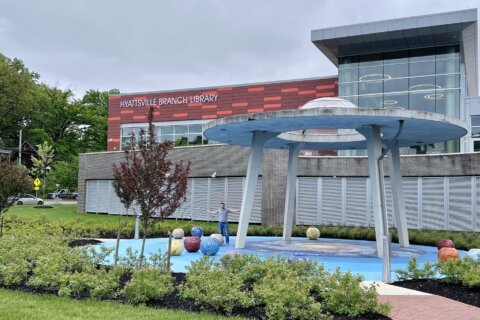WASHINGTON — He made history by commanding NASA’s final shuttle mission in July 2011.
Now, retired astronaut Chris Ferguson lends his astronomical experience to “Journey to Space,” a new 3D IMAX film at the Smithsonian’s National Air and Space Museum.
“The space program will never leave us. It lives in all our imaginations. … It’s just a chapter in a book that’s a very long journey,” Ferguson tells WTOP. “We’re in space as a species to stay; there’s no question in my mind. The only question is, how long does it go between great advancements?”
“Journey to Space” seeks to answer that question, showing what NASA has planned for future generations. The 43-minute film is directed by Mark Krenzien, narrated by Patrick Stewart (“Star Trek”) and features interviews with both Ferguson and rising astronaut Serena Aunon, who says, “I don’t know if I’ll ever get to walk on Mars, but I may already know some of those who will.”
“The story kind of flows from some wonderfully spectacular space shuttle footage, all the way up to what vehicles would look like and what’s on the drawing board for vehicles to go to Mars,” says Ferguson, whose favorite space movie is “Apollo 13” (1995). “(It explores) the space suits they’ll use, how they’ll live, how they’ll breathe and where we’re headed as a species beyond the Earth’s orbit.”
Ferguson joined NASA in 1998 as a naval officer and pilot before spending 13 years as an active astronaut, including three space shuttle missions to the International Space Station.
“I grew up in the age of Apollo. When I was a young, impressionable kid, I watched Neil Armstrong walk on the moon. I was probably eight years old at the time, and I wanna think I sorta got bit at the time, but that was what other people did. … I couldn’t possibly aspire to something like that.”
Instead, he went to college, joined the Navy, went to test pilot school and got a graduate degree.
“A few years into that adventure, I realized that everything the former astronauts had done, I had accomplished — not with the expressed intent of becoming an astronaut one day, but I thought, sure, what the heck? Let’s give it a try. I applied a couple of times and got really lucky once.”
His first trip to space in 2006 offered a truly breathtaking moment.
“We had launched in the daytime, but we rapidly flew into the sunset and spent about 30 minutes going through what was ‘orbital night.’ … When the sun first came up … I was very busy with my head buried down in the pilot seat, and I looked up, expecting to see the darkness of space, and there was the Earth … I think the words out of my mouth were, ‘Oh my gosh.’ Even if you had tried to imagine what that experience would be like, it did not hold a candle to the reality. It was an out-of-body experience where you get to see the Earth not blurred by borders, and oceans are beautiful blue, and forests are just jade green, and it really is just an amazing experience. It’s hard to convey in words.”
He says such an awe-inspiring experience reminded him how small we are in the grand picture.
“There are probably billions of suns just like our own out there, and those suns probably have billions of planets orbiting them, and the odds that none of them are like our Earth are very remote, so I think that it’ll be a matter of time,” Ferguson says. “We’ve been poking around on Mars for a couple of decades now. We haven’t found the Holy Grail, but I think there has been overwhelming evidence that there used to be a very deep ocean on Mars, and where there’s oceans, there is usually life.”
Ferguson, who now works for Boeing, points to a bubbly substance recently discovered on one of Saturn’s moons, as well as ice caps of Jupiter’s Europa moon, as examples of the type of “inferred evidence” that may one day confirm the existence of extraterrestrial life.
“I think we’ll infer life before we actually discover it. But I think both of those are just a matter of time.”
He says such discoveries are not merely a curiosity of mankind, but its destiny.
“If you look at our destiny, hundreds of years ago we set off from the shores of Europe to go explore the globe, and we seem to be poised in a very similar position right now to set off from the shores of Earth and go to other places that we can go to,” he says. “I can understand why some of my predecessors … went up six different times. It’s an amazing experience that just draws you back, and it makes you wonder if there’s not a little part of us that realizes that we belong out there.”
Hear the full interview below:
Click here for more information on “Journey to Space” in 3D IMAX at the Smithsonian’s National Air and Space Museum in Washington D.C.








